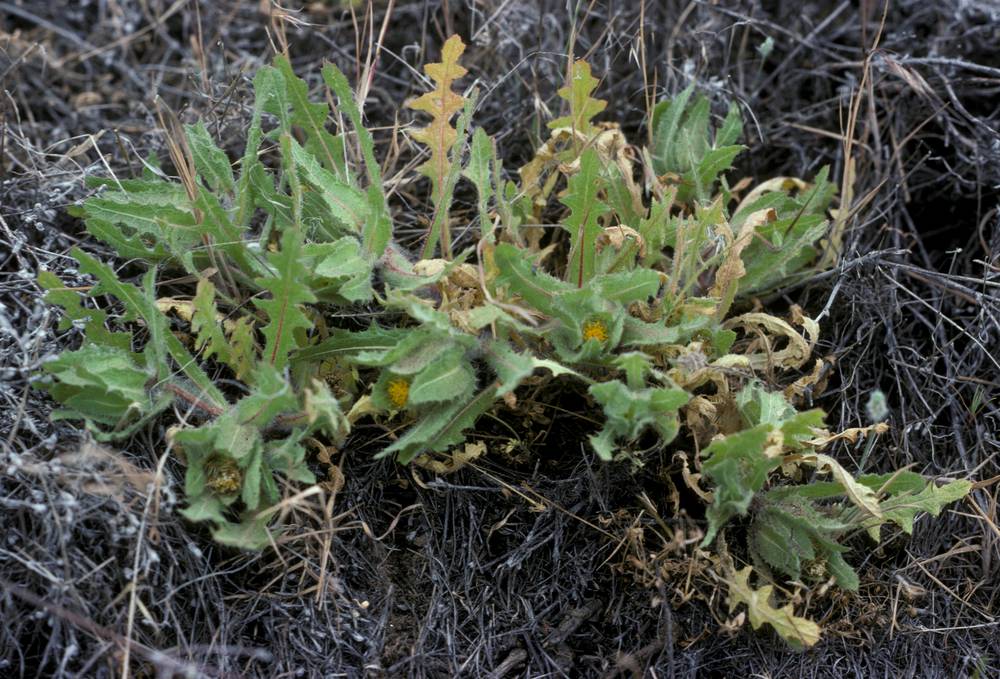Centaurea melitensis
Centaurea benedicta
Maltese starthistle, tocalote
blessed thistle
branched above, sparsely tomentose;
gland-dotted.
usually much branched, sparsely to densely tomentose.
villous, thinly to densely tomentose;
gland-dotted;
basal and lower cauline blades oblong to oblanceolate, 2–15 cm;
margins dentate, pinnately lobed or entire, petiolate to tapering at base; upper cauline blades linear to oblong, 1–5 cm, bases decurrent;
margins dentate to entire.
cauline, rarely also basal, oblanceolate to elliptic, 6–25 cm;
margins shallowly to deeply pinnately lobed, dentate, armed with short weak spines;
surfaces sparsely to densely tomentose, becoming glabrate;
gland-dotted;
petioles winged.
1–few in corymb-like arrays or heads solitary.
solitary heads.
ovoid, 8–15 mm.
± spherical, 20–40 mm.
yellow, sterile florets ? fertile florets, fertile florets 10–14 mm.
yellow, sterile florets 3-lobed, not exceeding fertile florets, fertile florets 19–24 mm.
outer ovate, bases spiny-fringed;
surfaces tomentose to glabrate;
central spines slender, 5–10 mm, often purple; inner entire; acute or spine-tipped.
tightly overlapping; outer ovate, green or straw-colored, with spreading spine tips;
central spines 8–15 mm; inner lanceolate, purple to straw-colored;
spines pinnately divided;
central spines 5–15 mm, sessile.
2.5–3 mm, white or light brown, finely hairy, pappi of unequal, white bristles, 1.5–3 mm.
8–11 mm; straw-colored, with 20 prominent ribs;
pappi in 2 series of awns; outer 9–10 mm; inner 2–5 mm.
disciform.
disciform, sessile, subtended and obscured by clusters of leaf-like bracts.
=24.
=22.
Centaurea melitensis
Centaurea benedicta
Disturbed areas, roadsides, open woods, fields, pastures. Flowering May–Jul. 0–700 m. CR, ECas, Est, Sisk, WV. CA, ID, NV, WA; scattered in North America; Africa, Asia, Europe. Exotic.
Disturbed areas, roadsides, fields. Flowering Apr–Aug. 50–900 m. BW, CR, Sisk, WV. CA, WA; scattered in North America; nearly worldwide. Exotic.
Bridget Chipman
Bridget Chipman
- Local floras:
BC,
CA,
OR,
WA
- Local Web sites:
CalFlora,
CalPhotos,
Flora NW,
PNW Herbaria
WildflowerSearch
iNaturalist (observations)
USDA Plants Database
- LBJ Wildflower Center
- SEINet
- Plants of the World Online
- Encyclopedia of Life
- Wikipedia
- Google Image Search
- Local floras:
CA,
OR,
WA
- Local Web sites:
CalFlora,
CalPhotos,
Flora NW,
PNW Herbaria
WildflowerSearch
iNaturalist (observations)
USDA Plants Database
- LBJ Wildflower Center
- SEINet
- Plants of the World Online
- Encyclopedia of Life
- Wikipedia
- Google Image Search





